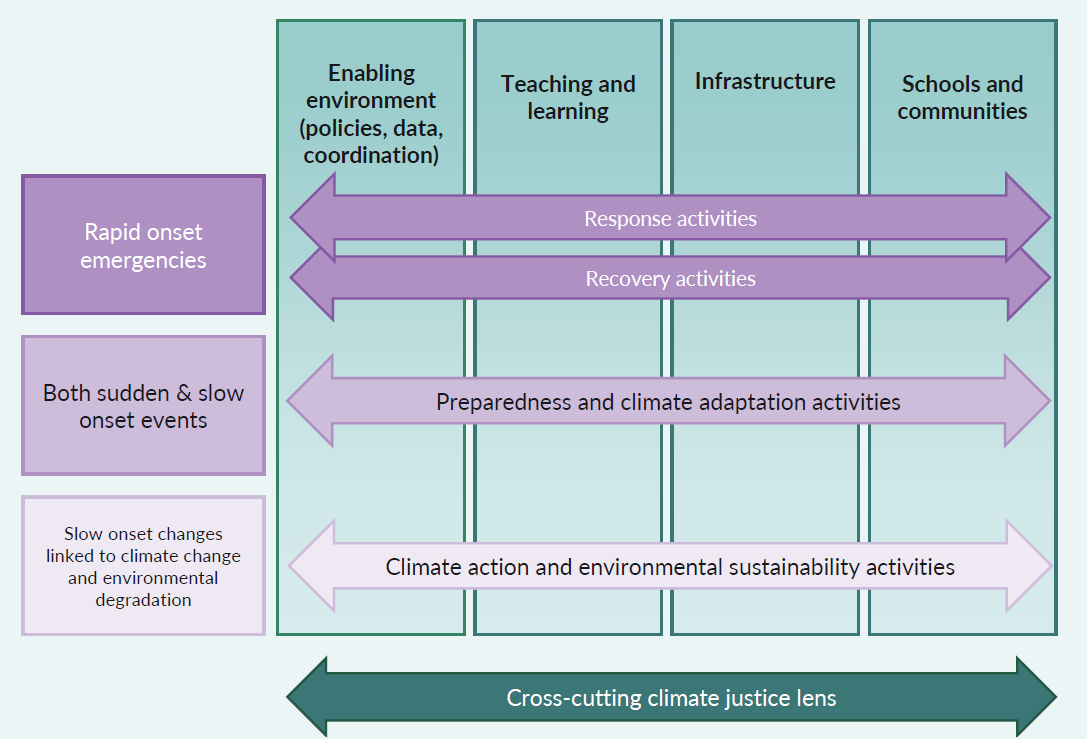How to Finance Climate-Smart Education: Launching an Evidence Review and a Costing Framework Tool
In this cross-posted blogpost, initially published by the Global Partnership for Education, Carly Munnelly, Anna-Maria Tammi and Raphaelle Martinez argue that education systems are not adequately prepared to deal with the impacts of climate change and that climate efforts fail to seize the potential of education for a more sustainable future. To address and mitigate the negative impacts of the climate crisis on education, increased and more effective financing is crucial. To achieve this goal, the authors propose a new costing framework for climate-smart education systems.
Children and communities around the world are facing the catastrophic impacts of the climate crisis and environmental degradation. The frequency of heatwaves, wildfires, droughts, floods and other climate-related disasters is increasing, posing significant challenges to education systems.
These disasters directly affect students and staff, causing injuries, health hazards and damage to schools and infrastructure. As a result, access to education is disrupted and learning is compromised.
To address and mitigate the negative impacts of the climate crisis on education, increased and more effective financing is crucial. Additional funding is needed to adapt or rebuild infrastructure in a way that’s safer and more resilient.
It’s also necessary to support preparedness and ensure learning continuity by planning and delivering alternative locations and modes of instruction. Education should also be adequately funded to reinforce its role in preparing learners to become agents of change for greener societies.
 A two-way relationship between education financing and the climate crisis
A two-way relationship between education financing and the climate crisis
We set out to review the literature to provide an overview of the evidence on the relationship between the climate crisis and financing for education and found the following:
- Available data and evidence on additional costs of the climate crisis to education are largely individual case studies. Despite a substantial body of evidence on the costs of hazards more widely, the review did not identify any regional or global estimates for the additional costs presented by the climate crisis on education systems.
- There’s a gap in the evidence that speaks to the cost of different climate-smart investments in education and their relative benefits. In contrast, there’s a strong body of evidence on the savings realized from implementing disaster risk reduction (DRR) interventions and preparedness more broadly.
- There is a substantial amount of data highlighting that strategies and investment for climate and education are not well integrated. While there has been progress in recent years to integrate education and climate strategies, the depth of this integration remains inadequate. This means that education systems are not adequately prepared to deal with the impacts of climate change and that climate efforts fail to seize the potential of education for a more sustainable future.
The danger is that this lack of information has led governments and donors to allocate insufficient funds to adapt education systems to climate change as well as safeguard children’s right to education as part of wider climate efforts.
This is true not only for education, but also for critical children’s services including health, nutrition and child protection.
The need for a country-specific lens
Although education is vulnerable to the negative impacts of climate change and is an important tool for climate action, review findings indicate a significant lack of evidence on the scale and type of additional costs the climate crisis may impose on education systems.
There’s also no common understanding of the types of interventions that should be supported to build climate-smart education systems, including what these interventions might cost and the savings they might provide on a longer term.
Indeed, our review of the evidence found that the costs of different interventions vary widely depending on the type of climate hazards as well as both within and across countries.
Therefore, the next step is to have country-specific costing data that responds to the types of hazards a given country is facing and reflects local costs of interventions. Collecting this data will help governments and donors prioritize impactful climate-smart interventions in their education systems.
A new costing framework for climate-smart education systems
We developed the Climate and Environment Intervention Matrix (CEIM) as a first attempt to map the different cost implications of building climate-smart education systems.
The CEIM organizes potential activities tied to developing climate-smart education systems into 4 categories:
- Response;
- Recovery;
- Preparedness and adaptation;
- Climate action and environmental sustainability.
The CEIM interlays these types of interventions with 7 dimensions of a climate-smart education system and includes a cross-cutting element of climate justice.
Save the Children and GPE are planning to work with country partners to collect and publish country specific costing data for some of the interventions outlined in the CEIM to help start building this evidence base that eventually could help building regional and global understanding of financing needs to build climate smart education systems.

The Climate and Environment Intervention Matrix – Summary Version
Directions for further research
To address the glaring evidence and data gap, we propose the following questions be taken up by the research community:
- What additional costs have the climate crisis imposed on education systems at country and regional levels?
- What are the specific costs, impacts and returns to climate-smart and gender-responsive interventions in education?
- What is the funding that is needed for preparedness and adaptation interventions in a given country?
- What are the innovative financing instruments and partnerships that can support more financing in the education sector for the benefit of both the climate and education sectors?
We invite researchers, practitioners and policy makers to join us in this endeavor and work collectively to implement an action-oriented research agenda, so that together, we can build a more resilient, greener and sustainable future for all.
About the Authors:
Carly Munnelly, Save the Children UK
Anna-Maria Tammi, Global Partnership for Education Secretariat
Raphaelle Martinez, Global Partnership for Education Secretariat

